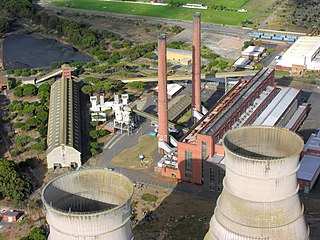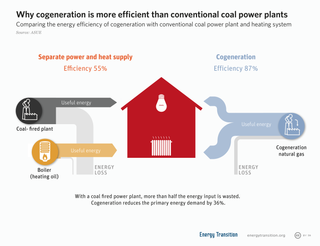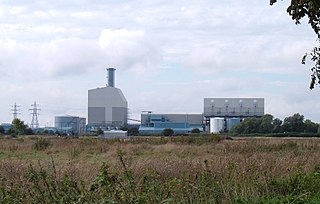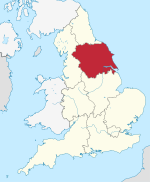
Electricity generation is the process of generating electric power from sources of primary energy. For utilities in the electric power industry, it is the stage prior to its delivery to end users or its storage.

A power station, also referred to as a power plant and sometimes generating station or generating plant, is an industrial facility for the generation of electric power. Power stations are generally connected to an electrical grid.

A combined cycle power plant is an assembly of heat engines that work in tandem from the same source of heat, converting it into mechanical energy. On land, when used to make electricity the most common type is called a combined cycle gas turbine (CCGT) plant. The same principle is also used for marine propulsion, where it is called a combined gas and steam (COGAS) plant. Combining two or more thermodynamic cycles improves overall efficiency, which reduces fuel costs.

Cogeneration or combined heat and power (CHP) is the use of a heat engine or power station to generate electricity and useful heat at the same time.

Peaking power plants, also known as peaker plants, and occasionally just "peakers", are power plants that generally run only when there is a high demand, known as peak demand, for electricity. Because they supply power only occasionally, the power supplied commands a much higher price per kilowatt hour than base load power. Peak load power plants are dispatched in combination with base load power plants, which supply a dependable and consistent amount of electricity, to meet the minimum demand.

A thermal power station is a type of power station in which heat energy is converted to electrical energy. In a steam-generating cycle heat is used to boil water in a large pressure vessel to produce high-pressure steam, which drives a steam turbine connected to an electrical generator. The low-pressure exhaust from the turbine enters a steam condenser where it is cooled to produce hot condensate which is recycled to the heating process to generate more high pressure steam. This is known as a Rankine cycle.
A load-following power plant, regarded as producing mid-merit or mid-priced electricity, is a power plant that adjusts its power output as demand for electricity fluctuates throughout the day. Load-following plants are typically in between base load and peaking power plants in efficiency, speed of start-up and shut-down, construction cost, cost of electricity and capacity factor.

Damhead Creek power station is a 792 MWe gas-fired power station in Kent, England, on the Hoo Peninsula, It is near the site of the decommissioned Kingsnorth power station. The plant entered service in February 2001.

The Littlebrook Power Station were a series of four oil and coal-fired power stations situated on the south bank of the River Thames, next to the Queen Elizabeth 2 Bridge and the Dartford Tunnel in Dartford, Kent. The final power station, Littlebrook D, ceased operating in March 2015, and has now been demolished.

King's Lynn Power Station refers to a combined cycle natural gas power station near King's Lynn in Norfolk, commissioned in 1997, and now owned by RWE, and to a coal fired power in King's Lynn in operation from 1899 to 1960. The CCGT station was mothballed on 1 April 2012. It can generate 325 MW of electricity and employed 40 people. The site was reopened on 19 November 2019.

South Humber Bank Power Station is a 1,365 MW gas-fired power station on South Marsh Road at Stallingborough in North East Lincolnshire north of Healing and the A180 near the South Marsh Road Industrial Estate. It is around two miles east of Immingham, and employs 64 people. The site of SHBPS is around 500 metres by 400 metres in area. It is next door to the Synthomer plant.

Peterborough Power Station is a 360MW gas-fired power station at Eastern Industry, Fengate in the city of Peterborough, Cambridgeshire in the United Kingdom. It employs around forty people.

Little Barford Power Station is a gas-fired power station just north of the village of Little Barford in Bedfordshire, England. It lies just south of the A428 St Neots bypass and east of the Wyboston Leisure Park. The River Great Ouse runs alongside. It was formerly the site of two coal-fired power stations, now demolished. The station is operated by RWE.

Roosecote Power Station was a gas-fired, originally coal-fired power station, situated in the Roosecote district of Barrow-in-Furness in Cumbria, North West England. The gas-fired station opened in 1991 and was the first CCGT power station to supply electricity to the United Kingdom's National Grid, but was mothballed in 2012 after a proposed biomass power station was cancelled. It was situated directly adjacent to Rampside Gas Terminal. The plant was demolished between 2014 and 2015. The site is now a 49 MW battery storage facility.

Connah's Quay Power Station is the name of the current 1,420 MW gas-fired power station near Connah's Quay in Flintshire in North Wales. The power plant, which is situated on the south bank of the River Dee, is the modern successor to a coal-fired power station which closed in 1984 and demolished in 1992. The replacement gas-powered plant was completed in 1996 and began producing electricity a year later. It originally received its gas from the Point of Ayr terminal, which in turn comes from the offshore gas fields in Liverpool Bay.

Ince Power Station refers to two demolished power stations near Ellesmere Port in Cheshire, North West England.

Taylors Lane Power Station is situated in Willesden, north-west London. The first power station on the site, known as Willesden power station, was coal-fired and operated from 1904 to 1972 and was subsequently demolished. Taylors Lane is now an open cycle gas turbine (OCGT) power station built in 1979.

Northfleet Power Station was a coal-fired, later oil-fired, power station on the south bank of the Thames at Northfleet, Kent. Opened in 1963, it was converted to burn oil in 1972, and closed in 1991.
Termosolar Borges is a hybrid biomass-parabolic trough solar thermal power plant which provides electricity to Spain's transmission system. It is located about 100 kilometres (62 mi) west of Barcelona, about 10 kilometres (6.2 mi) south-east of Lleida, near Les Borges Blanques, Catalonia, Spain.
Watford Power Station was a coal-fired power station situated in Watford's Riverside area. The station was built by the Watford Corporation Electricity Department starting with the installation of cables in 1899 with completion around 1900, near the banks of the River Colne. A gas turbine power station was commissioned in 1980.




















